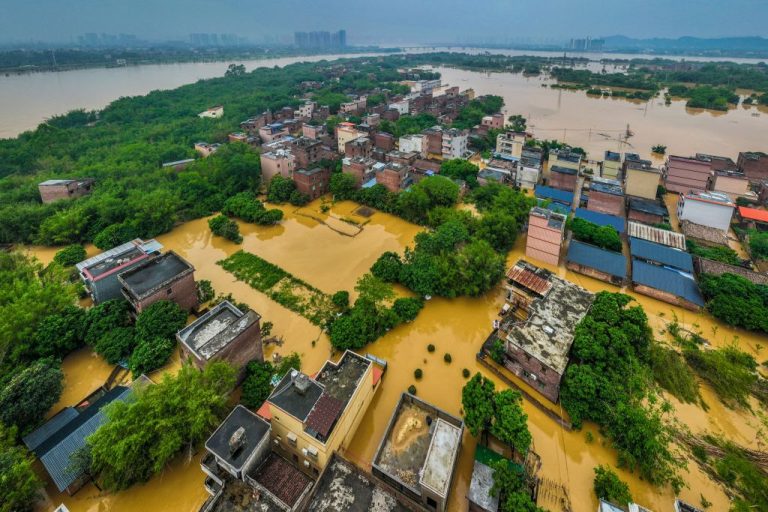For more than two weeks, Shanghai has been impacted by drastic citywide lockdowns that seem unable to quell the rapidly rising number of new COVID-19 infections. According to data released by China’s health authorities, case numbers continue to soar in the coastal metropolis of 26 million people — with the city adding more than 27,700 new infections on April 13.
On April 9, authorities in the country’s financial capital announced the opening of the largest makeshift hospital in the country. The city’s National Convention & Exhibition Center has been turned into a COVID ward with a capacity of 50,000 beds, and it isn’t the only one of its kind.
READ MORE:
- Volunteer Workers Assisting Shanghai in Pandemic Controls Accused by Authorities of Bringing COVID Home
- Public in Uproar as Shanghai Authorities Separate Children From Parents in ‘Zero-COVID’ Protocols
- Desperate Residents Protest Shanghai Lockdown: ‘You are driving people to their deaths’
According to state-media newspaper The Global Times, Shanghai has built more than 100 makeshift hospitals, offering over 160,000 beds for COVID-19 patients.
Sleeping on cardboard boxes
However, netizens have taken to social media to show the horrible conditions they are kept in inside these makeshift hospitals. Videos and pictures show dozens of people crammed into small rooms with insufficient beds. In some cases, people can be seen sleeping on cardboard boxes on the floor.
The Chinese post read: “It’s 4:00 a.m. now. I haven’t been able to rest well inside this quarantine camp for the past 14 days. It’s too noisy to fall asleep during the day, and during the night, the blinding white lights keep us up all night.”
The resident continued describing her ordeal, “How long will it take for the quarantine to be lifted? I am starting to feel sicker by the day. I am now suffering from anxiety, heart palpitations, hypoglycemia, dizziness, and tinnitus.”
“I haven’t been able to bathe or change my clothes for more than ten days. Life inside this makeshift hospital is really a nightmare,” she said.
Leaking roofs
Success
You are now signed up for our newsletter
Success
Check your email to complete sign up
On April 13, a blogger wrote about one of the quarantine sites’ roofs starting to leak after heavy rainfall experienced in Shanghai over the last few days.
A now censored user wrote on Weibo (China’s Twitter-like platform) that he had put up with his belongings being stolen, the thin blankets they were given, as well as the broken water heater and toilets, but described how the heavy rainfall was causing water to leak all throughout the building, putting everyone further on edge.
“Many people inside have a fever, cough and other symptoms, I don’t know what I’m going to do tonight, or where I’m going to sleep,” the blogger wrote.
A mainland-based media outlet followed the story and reported on another resident who was live-streaming from the Nanhui camp showing how the leaks were causing the roofs to partially collapse and the entire facility to lose water and electricity.
Building forts out of blankets
Another resident named Zhuyi took to Weibo to document his 11 day stay inside one of the makeshift COVID wings. One week into his stay at the hospital, the blogger described how the facility’s 24/7 lighting started to have an adverse effect on the quarantined residents.
Finding it hard to fall asleep, residents used blankets to build tent-like forts that shrouded their cardboard beds in darkness. “It looks like a refugee tent from afar, but that’s how we are sleeping in here,” the blogger wrote.
Another issue Zhuyi encountered was a shortage of washing facilities, which were unable to meet the demands of the patients on-site. As a result, he described how they were only able to shower once every five days.
“There is a 30-meter-long queue in front of a few taps of icy cold water,” he wrote, before adding, “Luckily, I have short hair now, because the water flow is slimmer than a chopstick.”
Prolonged lockdowns show no end in sight
Shanghai’s citywide lockdown was scheduled to be conducted in two phases. The city’s Pudong financial district and nearby areas were first placed into lockdown from March 28 to April 1. Authorities said the restrictive measures were put in place in order to allow health workers to conduct at least two rounds of mass testing.
In the second phase of the lockdown, the vast downtown area west of the Huangpu River that divides the city started its own five-day lockdown lasting from April 1 to April 5.
On the day the lockdowns were scheduled to be lifted, however, residents were told that due to the severity of the pandemic and the rapidly growing number of new infections, the measures would have to be extended until further notice.
In its drive to completely eradicate the pandemic from China, the Chinese Communist Party has placed entire cities into lockdowns for weeks on end under its “Zero-COVID” strategy. The stringent measures have resulted in severe impacts to the national economy as well as to the mental health and social life of residents across the country.















